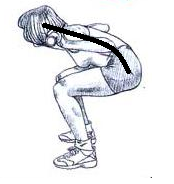Midline Stabilization
"So what do you do for abs?"
A question common for CrossFit gyms, as if the only measure of fitness is a 6-pack.
Much of the public believes that the road to a strong midsection involves a multitude of crunches, curl-ups, sit-ups, and any and all other abdominal exercises. The goal is almost always aesthetic. “Core work,” it gets named.
In reality, stomach muscles can be seen with minimal body fat, no matter how strong a person is. If six little abdominal bumps are the goal, much of what people are looking for can be achieved through nutrition. And sometimes, even unhealthy individuals have visual abs. Skinny isn't necessarily fit, remember. Everyone has a 6-pack, it's just a matter of what exists on top of it, between the muscles and the skin on the subcutaneous level.
If core strength is the goal, perhaps the best analogy would be the game of Jenga. The strongest position is with all supporting pieces in place. The more the blocks are moved out of sorts, the less stable the tower becomes.
This is like our body, if we consider our spine like a midline of building blocks then the supporting pieces stabilize our overall structure.
If we look at the anatomy and physiology of the abdomen, our musculature is set up to stop unwanted movement of the spine. Sure, the abs do in fact flex to bring the ribs and hips closer to each other, and our back muscles extend to open that distance, but resisting movement is one of the primary functions of the muscles in our midsection. Thus, resisting movement is one of the greatest core strengthening exercises an athlete can do. This is an additional reason why gymnastics positioning or squatting heavy or going overhead with weight are all such great moves.
If we resist movement, the midline strengthens. Like a solidified tower in Jenga, complete with the middle blocks intact.
A common example is the following scenario: Imagine you are going to help a friend push their broken down car. For whatever reason they ran out of gas and you’re with them, close to the gas station—but instead of walking for gas you need to help push while they steer. Just go with it, alright? As you prepare to push, you don’t stand straight up and place your hands on the car as if you were in a vertical push-up position. You want multiple muscle groups involved, right? Well, actually, this thought probably wouldn’t go through your mind... instead you'd say to yourself, “Why couldn't they watch the damn gauges?" Nonetheless, you sigh and then realize you'll need to use your entire body. You put one foot in front of the other, drop your body down low, and use legs as well as upper body to get the car rolling.
What most people rarely realize in this situation-- never think to do, but would come naturally-- is we'd all take a deep breath, hold it, and brace for the push by tightening our core and midsection.
Functional fitness at its finest.
The body is staying safe by resisting spinal movement, but it's also putting itself into the strongest position possible. Like a Jenga game, before anyone starts picking the pieces apart. And like Jenga, we want all our pieces in place. This requires strategy, a steady hand, and maybe even a touch of luck.
Our abs are in plain vision any time we look in the mirror. Maybe we worry about our flaws, like the holes in a Jenga tower. But while we constantly see our front, the posterior human anatomy is just as important when aiming for strength and athleticism. Plus, a solid back side of the body keeps us young for years past our prime; think of our weak elderly population who have lost the posterior strength to stand upright. Our great-grandparents can often be seen staring at the ground is an atrophied state of posterior musculature.
Bounded by the abdominal wall, the pelvis, the lower back, the diaphragm and their ability to stabilize the body during movement are key to any athletic endeavor or general fitness program. The main muscles involved are the rectus abdominis, the transversus abdominis, the internal and external obliques, the quadrates lumborum, the psoas, the diaphragm, the erector spinae, the multifidus, and the gluteus muscle group. [1] [2] [3] [4]
When the abs, back extensors, glutes, and surrounding muscles are “on,” the body is as rigid as it can be. Couple that physical work with healthful nutritional choices, and muscle cells increase while body fat decreases. A steady stack of Jenga blocks, the midline is strong and protected. No matter what the abs look like from the outside.
Movements for a Strong Midline:
Handstand Work: in order to not fold on top of yourself while upside down, the abs and back need to be strong. This gymnastic move also flows best when a hollow position is understood and put into practice.
Hollow Rocks: this is a static global flexion that tightens from the legs through to the shoulders. Hollowing out is a set position in much of gymnastics and related exercise-- in CrossFit, this is namely push-ups, handstands, ring dips, pull-ups, and muscle-ups.
Overhead Work: shoulder press, push press, and jerk exposes midline stabilization issues. Holding heavy weight overhead requires a strong and set midline.
Kettlebell Swings: hit a few of these and you can tell that the midline needs to be tight to keep from losing the bell between your legs. Remember, it's not just the front of the body that stabilizes the spine; these will hit lower back stabilizers and immediately expose any lumbar weakness.
L-sits: this isometric hold can leave your upper abs sore for days. Soreness is not congruous with fitness benefits, but just like handstands, L-sits can only be performed if the midline is strong.
Sled Push/Pulls: remember our car example from before? Besides the sheer work capacity and leg drive development, setting the midsection in order to move heavy weight is a great midline exercise.
Squats: maybe it's not traditionally thought of as a midline developer, but squat with a load in the back, front, or overhead position and stability is extremely necessary. Do a "dog shit squat" and injury is leaning your way, like a faltering Jenga tower. Squat heavy and squat often, but squat correctly.
Deadlifts: once again, it's not all about the front of the body. The midline is stabilized with the posterior muscles as well.
Of course this all transfers to simple body posture as well... both sitting and standing body positions. Once you see it, it cannot be unseen. And once you experience a solid midline, you can feel the change in trunk positioning any time it is compromised. This is where spinal disc issues can arise, in the unprotected spine. Muscles of the abdomen all exist to support core stabilization and protect the spine from unnecessary shifting and shearing in the structures of the vertebrae.
So there it is. Teetering like Jenga blocks, but delegated as a major player in overall fitness, midline stability deserves attention so the entire body structure remains sound. Tighten the core muscles and stabilize the spine, because the work typically required in CrossFit, or any quality fitness program, has no mercy for a weak midline.
Your move, or lack thereof.
- Scott, 8.19.2014




















